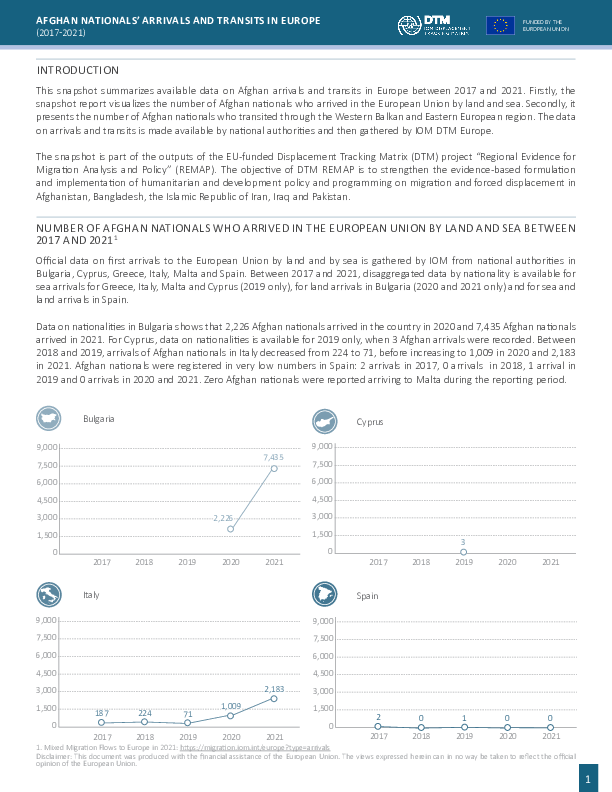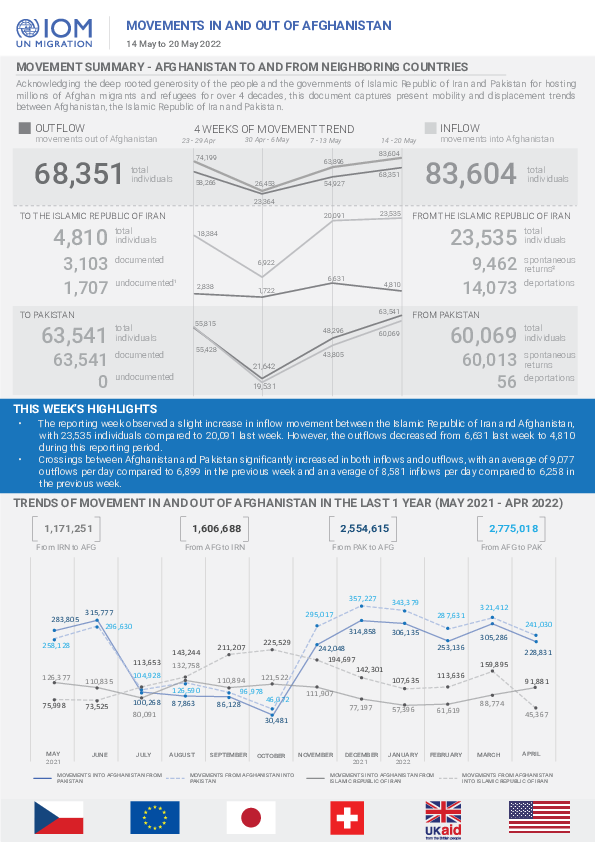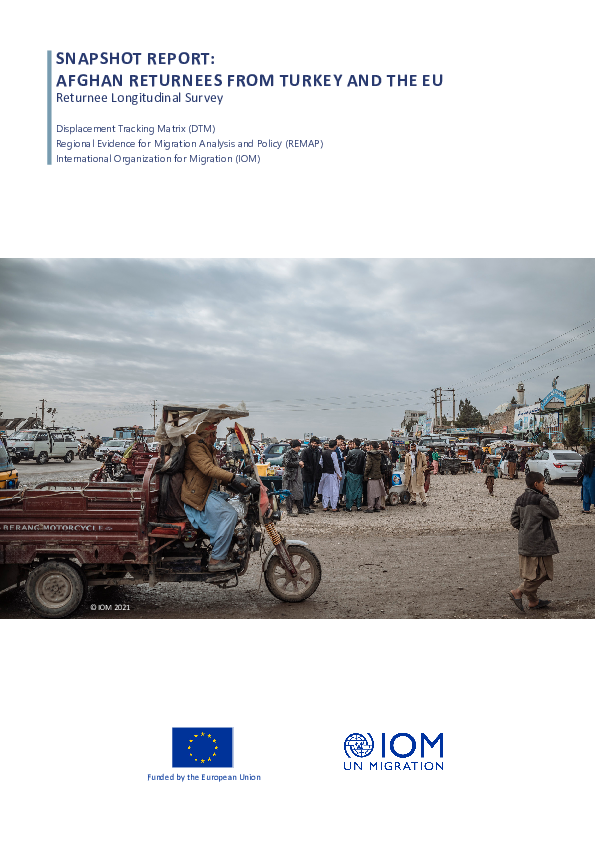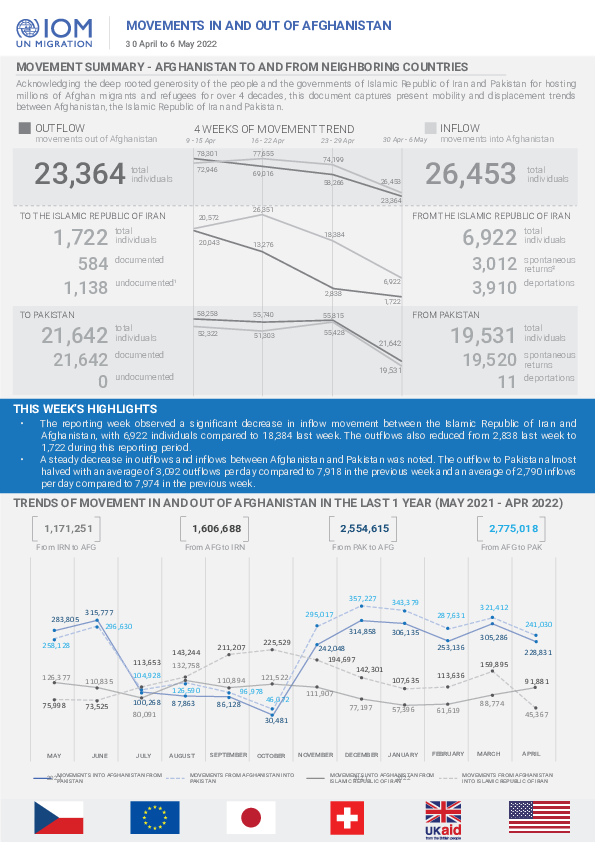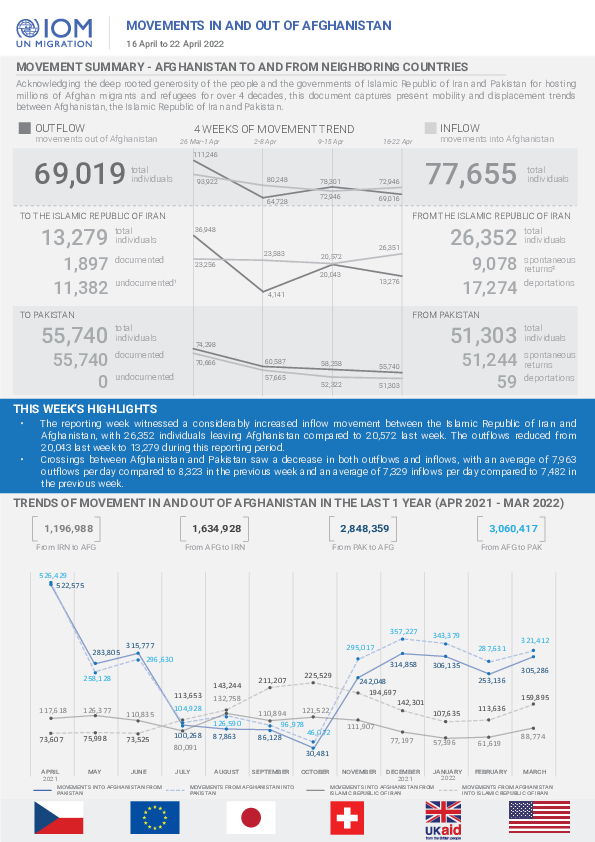-
Countries
-
Data and Analysis
-
Special Focus
-
Crisis Responses
Afghanistan
Afghanistan
IDPs tracked
Displacement Movements
4,187,000
IDMC 2023
Data collection round
About Afghanistan
The Displacement Tracking Matrix (DTM) is an information management system of tools and methodologies used to track and monitor displacement and population mobility. In Afghanistan, IOM activated the DTM programme in January 2017 in response to the substantial increase of Afghans returning home from neighbouring countries, as well as record levels of internal displacement. DTM in Afghanistan is designed to regularly and systematically capture, process and disseminate multi-layered information about the population sizes, locations, geographic distribution, movements, vulnerabilities, evolving multisectoral needs, and the drivers of migration of returnees, IDPs, migrants and mobile populations. DTM implements baseline mobility assessments, flow monitoring, registrations, and various migration surveys to provide an essential evidence base that enables decision-makers and humanitarian, reintegration and development partners to maximize resources and deliver efficient, better-targeted, mobility-sensitive and sustainable humanitarian; reintegration, community stabilization and development programming.
The value-added impact of DTM in Afghanistan is to inform action and results for people in need. DTM Afghanistan implements its activities at both the national and provincial levels. DTM works closely with other (IOM) programmes through referring identified populations in need of assistance at flow monitoring points to IOM’s Cross Border Return and Reintegration, Protection, Humanitarian Assistance, and Reintegration and Development (RADA) programmes. DTM Afghanistan also supports humanitarian partners and clusters, including WFP, FAO, UNHCR, IRC, DRC, NRC, and WHO, among many others, by providing emergency tracking updates in large-scale or sudden onset movements, such as emergency event tracking and drought response. Furthermore, stabilization and development actors, including IOM’s RADA programme, and the World Bank leverage DTM’s information to select priority communities and districts with higher concentrations of IDPs and returnees to receive reintegration and livelihoods assistance and improvements to core infrastructure and essential services. In support of health partners, including WHO, UNICEF, and the Humanitarian Health Cluster, DTM data informs the selection of priority, at-risk districts, border areas, communities, and health facilities in need of strengthened capacity, response, surveillance, and risk education for polio, TB, COVID-19, and other infectious diseases.
Contact
Modher ALHAMADANI
Senior Programme Coordinator - DTM
malhamadani@iom.int
DTM AFGHANISTAN
DTMAFGHANISTAN@iom.int
Current Donors
- Republic of Korea
- Norway
- CERF
- Canada
- Italy
- EU
- FCDO
Movement in and Out of Afghanistan Snapshot (16 - 31 July 2022)
The snapshot captures present mobility and displacement trends between Afghanistan, the Islamic Republic of Iran and Pakistan, between 16 July and 31 July 2022.
Afghanistan - Nangarhar Province: Baseline Mobility and Emergency-Community Based Needs Assessment, Round 15 (March-April 2022)
DTM has been conducting the Baseline Mobility Assessment in Afghanistan since 2016 to track mobility, provide information on population estimates, locations and geographic distribution of displaced and returnee populations, reasons for displacement, places of origin and periods of displacement.
Afghanistan - Herat Province: Baseline Mobility and Emergency-Community Based Needs Assessment, Round 15 (March-April 2022)
DTM has been conducting the Baseline Mobility Assessment in Afghanistan since 2016 to track mobility, provide information on population estimates, locations and geographic distribution of displaced and returnee populations, reasons for displacement, places of origin and periods of displacement.
Afghanistan - Helmand Province: Baseline Mobility and Emergency-Community Based Needs Assessment, Round 15 (March-April 2022)
DTM has been conducting the Baseline Mobility Assessment in Afghanistan since 2016 to track mobility, provide information on population estimates, locations and geographic distribution of displaced and returnee populations, reasons for displacement, places of origin and periods of displacement.
Afghanistan - Balkh Province: Baseline Mobility and Emergency-Community Based Needs Assessment, Round 15 (March-April 2022)
DTM has been conducting the Baseline Mobility Assessment in Afghanistan since 2016 to track mobility, provide information on population estimates, locations and geographic distribution of displaced and returnee populations, reasons for displacement, places of origin and periods of displacement.
Afghanistan - Survey on Drivers of Migration - Round 3 (April - August 2021)
This report demonstrates how Afghan mobility is the result of a range of factors related to economic conditions and prolonged conflict within the country. Between April 2021 and August 2021 (Round 3 of SDM), various provinces of Afghanistan were affected by active conflict, which was followe
Afghanistan - Survey on Drivers of Migration - Round 2 (November 2020 - March 2021)
This report will demonstrate how Afghan mobility is the result of a range of factors related to economic conditions and prolonged conflict within the country.
Movement in and Out of Afghanistan Snapshot (01- 15 July 2022)
The snapshot captures present mobility and displacement trends between Afghanistan, the Islamic Republic of Iran and Pakistan.
Afghanistan - Kabul Province: Baseline Mobility and Emergency-Community Based Needs Assessment, Round 15 (March-April 2022)
DTM has been conducting the Baseline Mobility Assessment in Afghanistan since 2016 to track mobility, provide information on population estimates, locations and geographic distribution of displaced and returnee populations, reasons for displacement, places of origin and periods of displacement.
Afghanistan - Key Findings: Baseline Mobility and Emergency Community-Based Needs Assessment, Round 15 (March-April 2022)
DTM has been conducting the Baseline Mobility Assessment in Afghanistan since 2016 to track mobility, provide information on population estimates, locations and geographic distribution of displaced and returnee populations, reasons for displacement, places of origin and periods of displacement.
Arrivals in the European Union (2021): Afghan, Bangladeshi, Iranian, Iraqi and Pakistani Nationals
This snapshot summarizes available data on Afghan, Bangladeshi, Iranian, Iraqi and Pakistani nationals’ arrivals in the European Union in 2021.
Afghanistan - Afghan Nationals' Arrivals and Transits in Europe (2017-2021)
This snapshot summarizes available data on Afghan arrivals and transits in Europe between 2017 and 2021. Firstly, the snapshot report visualizes the number of Afghan nationals who arrived in the European Union by land and sea.
Jul 14 2022
Afghanistan - Afghan Nationals' Arrivals and…
Afghanistan — RLS Snapshot Report Round 5 (7 – 26 May 2022)
To better understand the demographic profiles, living conditions and reintegration processes of Afghan returnees, IOM, under the EU-funded project “Displacement Tracking Matrix Regional Evidence for Migration Analysis and Policy (DTM REMAP)”, developed the Returnee Longitud
Afghanistan — Baseline Mobility and Emergency Community-Based Needs Assessment Report (Round 15, March—April 2022)
DTM has been conducting the Baseline Mobility Assessment in Afghanistan since 2016 to track mobility, provide information on population estimates, locations and geographic distribution of displaced and returnee populations, reasons for displacement, places of origin and periods of displacement.
Movement in and Out of Afghanistan Snapshot (16- 30 June 2022)
The snapshot captures present mobility and displacement trends between Afghanistan, the Islamic Republic of Iran and Pakistan.
Movement in and Out of Afghanistan Snapshot (01- 15 June 2022)
The snapshot captures present mobility and displacement trends between Afghanistan, the Islamic Republic of Iran and Pakistan.
Afghanistan - RLS - Snapshot Report Round 4 (February - March 2022)
This report provides a snapshot of the fourth round of RLS data collection which took place from 23 February to 16 March 2022 among Afghan migrants who had returned from Türkiye or the EU between January 2018 and July 2021.
Movement in and Out of Afghanistan Snapshot (14- 20 May 2022)
The snapshot captures present mobility and displacement trends between Afghanistan, the Islamic Republic of Iran and Pakistan.
Movement in and Out of Afghanistan Snapshot (07 - 13 May 2022)
The snapshot captures present mobility and displacement trends between Afghanistan, the Islamic Republic of Iran and Pakistan.
Snapshot Report: Afghan Returnees from Turkey and the EU
This report is the result of the first round of data collection that took place from May to August 2021 with Afghan migrants who returned from Turkey and the EU in 2018, 2019, 2020 and 2021 through IOM’s Assisted Voluntary Return and Reintegration (AVRR) and Stabilisation, Reint
Afghanistan - Survey on Drivers of Migration - Summary Brief on Debt (Round 2 and Round 3)
The Survey on Drivers of Migration (SDM) is part of IOM's EU-funded Displacement Tracking Matrix (DTM) "Regional Evidence for Migration Analysis and Policy" (REMAP) project. The objective of DTM REMAP is to strengthen the
Movement in and Out of Afghanistan Snapshot (30 April - 06 May 2022)
The snapshot captures present mobility and displacement trends between Afghanistan, the Islamic Republic of Iran and Pakistan.
Movement in and Out of Afghanistan Snapshot (23 - 29 April 2022)
The snapshot captures present mobility and displacement trends between Afghanistan, the Islamic Republic of Iran and Pakistan.
Movement in and Out of Afghanistan Snapshot (16 - 22 April 2022)
The snapshot captures present mobility and displacement trends between Afghanistan, the Islamic Republic of Iran and Pakistan.
Pagination
Pagination
Pagination
- First page
- Previous page
- 1
- 2
- 3
- 4
- 5













